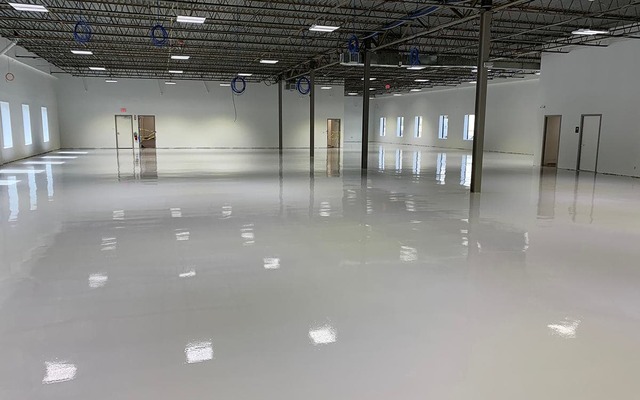Importance of Real-Life Examples
Real-life case studies provide valuable insights into the application, challenges, and outcomes of industrial epoxy flooring projects. By examining successful implementations, industry professionals and facility managers can glean practical knowledge and best practices for their flooring projects.
Case Study 1: Project Overview, Challenges, Solutions, Results
Project Overview: A large-scale manufacturing plant sought to upgrade its flooring to enhance durability and chemical resistance. The facility required a seamless flooring solution capable of withstanding heavy machinery and frequent chemical spills.
Challenges: Surface preparation revealed extensive cracks and unevenness, posing a challenge to achieving a smooth substrate for epoxy application. Strict timelines and operational constraints added pressure to minimize downtime during installation.
Solutions: Utilizing advanced surface preparation techniques such as diamond grinding, the team addressed substrate imperfections. High-build epoxy coatings were applied in multiple layers to ensure optimal thickness and durability.
Results: The industrial epoxy flooring surpassed expectations, providing a seamless, high-gloss surface that enhanced light reflectivity and improved workplace safety. Chemical spills were easily contained and cleaned, reducing maintenance costs and downtime significantly.
Case Study 2: Project Overview, Challenges, Solutions, Results
Project Overview: A pharmaceutical facility required sterile flooring that could withstand daily sanitation procedures and stringent regulatory compliance. The flooring solution needed to meet FDA standards for cleanliness and chemical resistance.
Challenges: Maintaining sterile conditions during installation was paramount, requiring meticulous planning and coordination. The flooring had to withstand frequent exposure to harsh disinfectants and sterilization agents without degradation.
Solutions: Epoxy flooring with antimicrobial additives was selected to inhibit bacterial growth and meet sanitary requirements. Installation was conducted in controlled phases to ensure minimal disruption to ongoing operations.
Results: The pharmaceutical facility achieved a pristine, hygienic environment with the new epoxy flooring. Regulatory inspections praised the seamless installation and adherence to cleanliness standards. The flooring’s durability minimized maintenance costs and upheld operational efficiency.
Case Study 3: Project Overview, Challenges, Solutions, Results
Project Overview: A distribution warehouse sought to upgrade its flooring to improve safety and operational efficiency. The facility needed a robust flooring solution that could withstand heavy traffic from forklifts and pallet jacks.
Challenges: Addressing surface imperfections and maintaining logistics operations posed significant challenges. The flooring solution had to accommodate rapid installation to minimize disruptions to warehouse activities.
Solutions: Epoxy mortar systems were applied to repair and level the substrate, enhancing load-bearing capacity. High-performance epoxy coatings were then applied to provide a durable, impact-resistant surface.
Results: The epoxy flooring solution enhanced the warehouse’s efficiency by reducing forklift wear and tear and improving traction for pedestrian safety. Minimal downtime during installation ensured continuous operations, while the flooring’s longevity provided long-term cost savings.
Highlight the Success and Benefits of Industrial Epoxy
The success stories from these industrial epoxy flooring projects underscore the versatility and durability of epoxy as a flooring solution. From manufacturing plants to pharmaceutical facilities and warehouses, epoxy flooring enhances safety, cleanliness, and operational efficiency. By choosing epoxy, industries can benefit from reduced maintenance costs, improved aesthetics, and enhanced workplace safety, making it a preferred choice for demanding industrial environments.
Frequently Asked Questions
What are the benefits of reviewing case studies for epoxy flooring?
Reviewing case studies provides real-world examples of how epoxy flooring solutions have been successfully implemented in various industrial settings. It helps stakeholders understand the challenges faced, the solutions applied, and the outcomes achieved, offering valuable insights for planning and decision-making.
How do case studies help in understanding epoxy flooring challenges?
Case studies detail the specific challenges encountered during epoxy flooring projects, such as surface preparation issues, operational constraints, or regulatory requirements. By analyzing these challenges and the strategies used to overcome them, stakeholders gain a comprehensive understanding of potential obstacles and effective solutions.
Can you provide examples of successful epoxy flooring projects?
Yes, successful examples include projects in manufacturing plants upgrading to epoxy for durability, pharmaceutical facilities using epoxy for sterile environments, and warehouses enhancing safety with epoxy flooring. Each case study highlights unique challenges and solutions tailored to specific industrial needs.
What criteria are important in evaluating industrial epoxy projects?
Key criteria include durability, chemical resistance, ease of maintenance, adherence to regulatory standards, impact resistance, aesthetics, and cost-effectiveness. Evaluating these aspects helps assess the suitability of epoxy flooring for different industrial applications.
How do industrial epoxy flooring solutions vary by industry?
Industrial epoxy flooring solutions are tailored to meet specific industry requirements. For example, food processing industries prioritize hygiene and FDA compliance, while warehouses focus on durability and safety. Pharmaceutical sectors emphasize sterile environments and chemical resistance.
What were the main challenges faced in these epoxy flooring projects?
Challenges often revolve around surface preparation complexities, tight project timelines, operational continuity requirements, and adherence to stringent industry standards for safety and hygiene. Overcoming these challenges is crucial for successful epoxy flooring installations.
How were specific challenges addressed during these projects?
Challenges were addressed through meticulous surface preparation techniques, strategic scheduling to minimize downtime, customized epoxy formulations to meet specific performance requirements, and collaborative efforts between project teams and flooring specialists.
What were the outcomes or results of these epoxy flooring installations?
The outcomes typically include enhanced durability, improved safety, easier maintenance, compliance with regulatory standards, and aesthetic improvements. These outcomes contribute to operational efficiency, cost savings, and a better working environment.
How did epoxy flooring improve safety in these case study projects?
Epoxy flooring improved safety by providing a non-slip surface, enhancing visibility with high-gloss finishes, and resisting chemical spills that could pose hazards. These safety enhancements reduce the risk of workplace accidents and injuries.
What lessons can be learned from these successful epoxy flooring projects?
Lessons learned include the importance of thorough planning and preparation, the value of choosing the right epoxy system for specific industrial needs, the effectiveness of collaborative project management, and the impact of proper maintenance on long-term flooring performance and durability.

